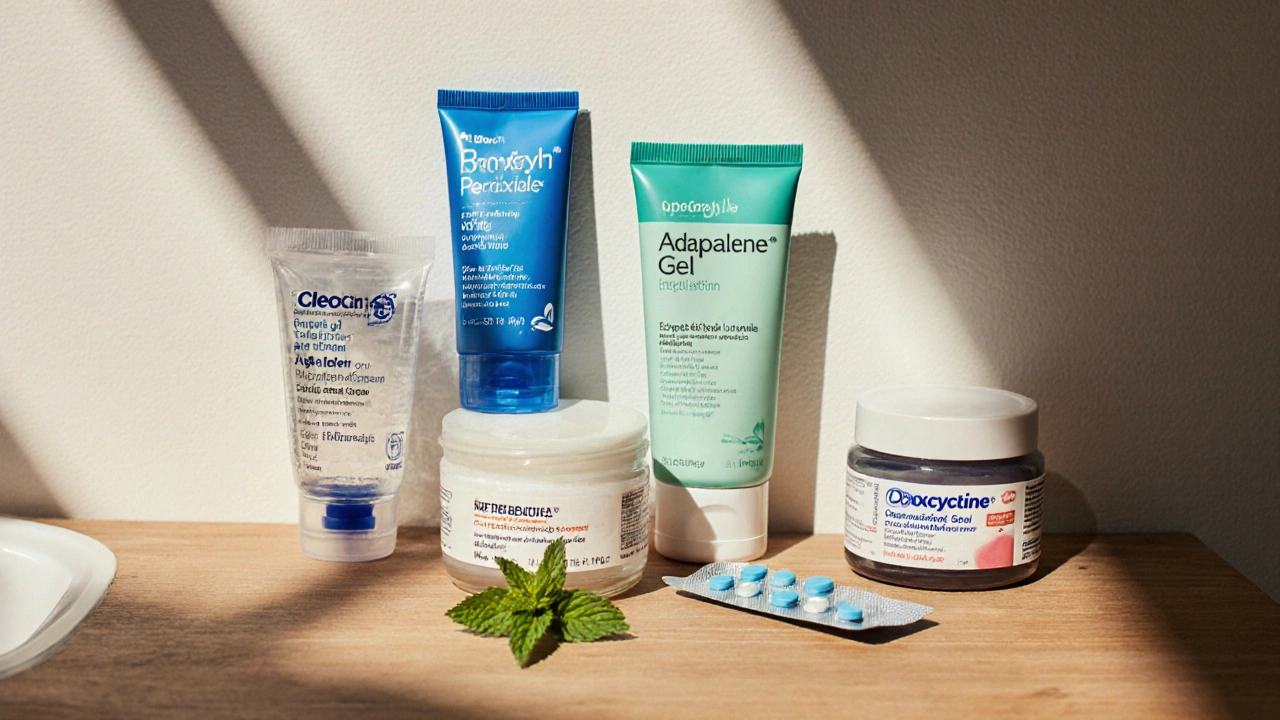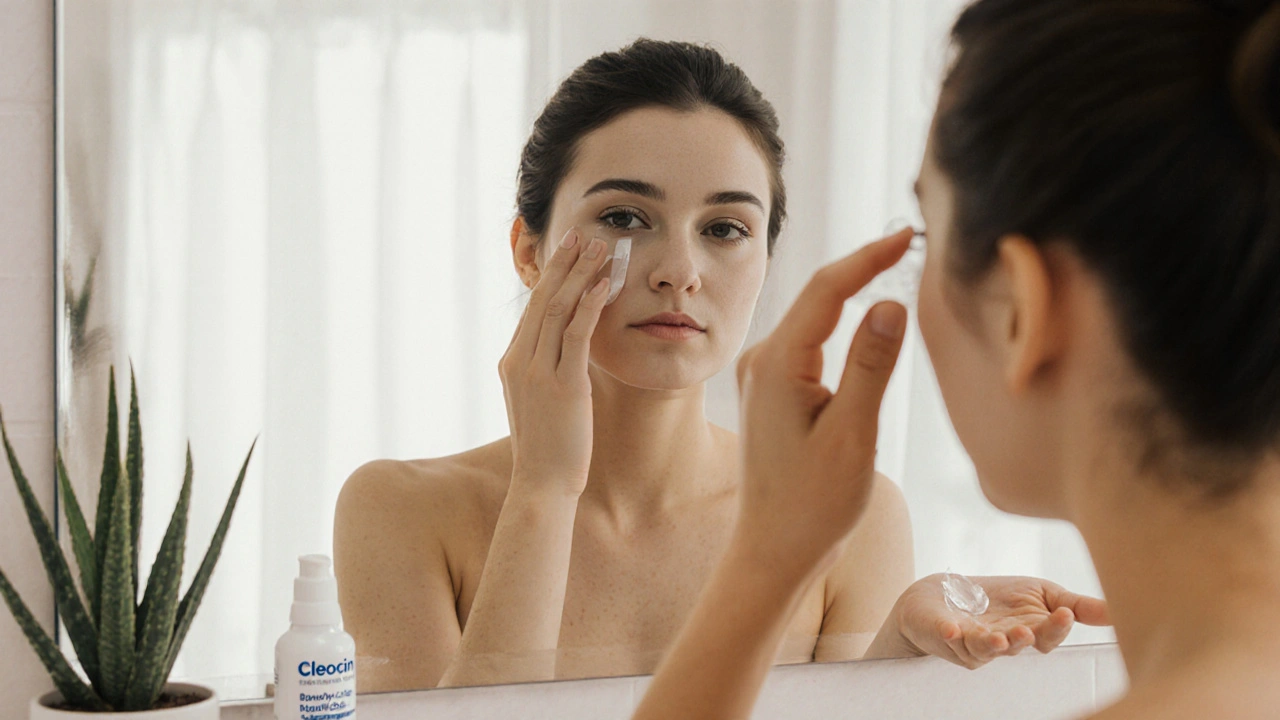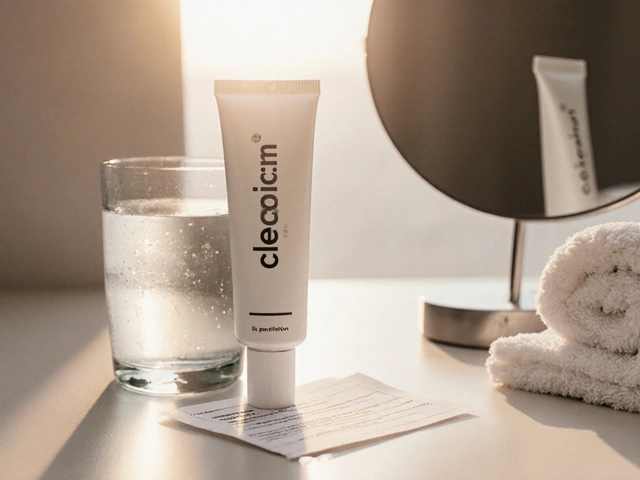Acne Treatment Selector
Recommended Treatment Plan
Why This Choice?
Key Considerations
When acne flares up, many people reach for a prescription gel that promises quick results. Cleocin Gel (clindamycin) is one of the most popular options, but it’s far from the only game‑changer on the market. This article puts Cleocin side‑by‑side with the most common alternatives, so you can decide which regimen fits your skin type, budget, and lifestyle.
Quick Takeaways
- Cleocin Gel is a prescription‑only topical antibiotic that attacks acne‑causing bacteria.
- Non‑antibiotic options like benzoyl peroxide and retinoids work by unclogging pores and reducing inflammation.
- Combination products (e.g., benzoyl peroxide+clindamycin) often give faster results with fewer resistance concerns.
- Oral antibiotics such as doxycycline are useful for moderate‑to‑severe acne but carry systemic side‑effects.
- Cost, skin tolerance, and treatment duration vary widely; choose based on your specific goals.
How Cleocin Gel Works
Cleocin Gel is a prescription topical antibiotic that contains 1% clindamycin phosphate. It targets Propionibacterium acnes (now Cuttibacterium acnes) by inhibiting bacterial protein synthesis, thereby reducing inflammation and the formation of papules and pustules. The gel’s lightweight base allows it to dry quickly, making it easy to layer under moisturizers or sunscreen.
Typical usage: apply a thin layer to clean, dry skin twice daily. Most dermatologists recommend a 6‑ to 12‑week trial before evaluating effectiveness.
Key Criteria for Picking an Acne Treatment
- Mechanism of action - Does it kill bacteria, unclog pores, or calm inflammation?
- Skin type compatibility - Oily, dry, sensitive, or combination?
- Resistance risk - Antibiotics can lose potency if overused.
- Side‑effect profile - Irritation, dryness, photosensitivity, systemic effects.
- Cost & availability - Prescription vs. over‑the‑counter, insurance coverage.
Side‑by‑Side Comparison Table
| Product | Active Ingredient | Formulation | Typical Use | Pros | Cons | Approx. US$ Cost (30‑day supply) |
|---|---|---|---|---|---|---|
| Cleocin Gel | Clindamycin 1% | Prescription gel | Twice‑daily topical | Targeted antibacterial action; well‑tolerated on most skin types. | Antibiotic resistance risk; requires prescription. | $30‑$50 (with insurance) |
| Benzoyl Peroxide 2.5% | Benzoyl peroxide | Over‑the‑counter gel/cream | Once‑daily or twice‑daily | Rapid bacterial kill; reduces resistance when combined. | Can cause dryness, peeling, bleaching of fabrics. | $10‑$20 |
| Adapalene Gel 0.1% | Adapalene | OTC retinoid gel | Once‑daily at night | Normalizes keratinization; long‑term efficacy. | Initial irritation, sun sensitivity. | $15‑$25 |
| Azelaic Acid 15% Cream | Azelaic acid | OTC cream | Twice‑daily | Anti‑inflammatory, reduces hyperpigmentation. | May sting on broken skin. | $20‑$35 |
| Doxycycline 100mg | Doxycycline | Oral capsule (prescription) | Once‑daily for 8‑12weeks | Systemic anti‑inflammatory; effective for moderate‑severe acne. | Photosensitivity, GI upset, potential gut flora impact. | $30‑$60 (generic) |
| Erythromycin Gel 2% | Erythromycin | Prescription gel | Twice‑daily | Another topical antibiotic option. | Higher resistance rates than clindamycin; can cause contact dermatitis. | $25‑$45 |

Deep Dive into the Alternatives
1. Benzoyl Peroxide
Benzoyl peroxide is an over‑the‑counter oxidizing agent that kills P. acnes by releasing free radicals. It also has mild keratolytic properties, helping to unclog pores. Because it works through oxidation, bacteria can’t develop resistance as they can with antibiotics. Most dermatologists recommend starting with a 2.5% concentration to minimize irritation.
2. Adapalene
Adapalene is a third‑generation synthetic retinoid that normalizes follicular epithelial desquamation and reduces inflammation. Since 2016 it’s been available OTC in the U.S., making it a go‑to for many who can’t get a prescription.
3. Azelaic Acid
Azelaic acid is a dicarboxylic acid that inhibits bacterial protein synthesis and reduces keratinocyte hyperproliferation. It’s especially helpful for people who also struggle with post‑inflammatory hyperpigmentation because it brightens skin.
4. Doxycycline (Oral)
Doxycycline is a broad‑spectrum tetracycline antibiotic that reduces both bacterial growth and inflammatory mediators. Doctors reserve it for moderate to severe acne, usually in combination with a topical agent.
5. Erythromycin Gel
Erythromycin gel is another topical antibiotic that interferes with bacterial protein synthesis, similar to clindamycin. Its use has declined because resistance rates have risen faster than for clindamycin.
When to Choose Cleocin Gel
If you have mild‑to‑moderate inflammatory acne (red pimples and small pustules) and want a targeted, prescription‑only solution, Cleocin is a solid choice. It works best when paired with a non‑antibiotic agent-like benzoyl peroxide-to prevent resistance. Ideal candidates are:
- People with dry or sensitive skin who can’t tolerate the dryness of benzoyl peroxide.
- Those who have tried OTC retinoids or acids without success.
- Patients who prefer a topical over oral antibiotics to avoid systemic side‑effects.
Safety, Side Effects, and Precautions
Common local reactions to clindamycin gel include mild itching, redness, or a slight burning sensation. These usually fade after the first week. Rarely, a contact dermatitis can develop, in which case therapy should be halted and a dermatologist consulted.
Because it’s an antibiotic, prolonged use beyond three months can foster resistant strains of P. acnes. That’s why most protocols suggest a limited course, followed by a maintenance regimen with a non‑antibiotic product.
Pregnant or breastfeeding individuals should discuss risks with their provider; clindamycin is generally considered safe, but oral antibiotics may have different safety profiles.
Cost and Accessibility Overview
Cleocin Gel requires a doctor’s prescription, which adds an office‑visit cost unless you have a tele‑dermatology service. Insurance often covers most of the price, bringing out‑of‑pocket expenses to $30‑$50 for a month’s supply.
OTC alternatives-benzoyl peroxide, adapalene, azelaic acid-are cheaper ($10‑$35) and can be bought without a prescription, but they may need a longer trial period to achieve comparable results.
Oral doxycycline, while generic and affordable, carries the highest risk of systemic side‑effects, so it’s usually reserved for heavier acne loads.
Putting It All Together: Choosing Your Regimen
Start by identifying your primary acne concern: bacterial inflammation vs. clogged pores vs. hyperpigmentation. If inflammation dominates and you prefer a prescription, go with Cleocin Gel and add a low‑dose benzoyl peroxide product after two weeks to keep bacteria in check.
If you’re comfortable with OTC options, begin with a benzoyl peroxide 2.5% gel in the morning and adapalene 0.1% at night. Introduce azelaic acid on alternate evenings if you notice lingering redness or dark spots.
For stubborn acne that hasn’t responded after 12 weeks, schedule a visit for oral doxycycline and a topical retinoid combo. Always follow up with a dermatologist to tailor the length of therapy and to monitor for side‑effects.

Frequently Asked Questions
Can I use Cleocin Gel and benzoyl peroxide together?
Yes. Applying benzoyl peroxide in the morning and Cleocin Gel at night is a common strategy. The peroxide kills bacteria immediately, while clindamycin prevents regrowth, reducing resistance risk.
How long before I see results with Cleocin Gel?
Most users notice reduced redness and fewer new lesions within 2‑3 weeks, but the full effect may take up to 8‑12 weeks. Patience is key, and you should keep using the product as directed.
Is clindamycin safe for teenagers?
Dermatologists frequently prescribe it to teens because it’s a topical treatment, limiting systemic exposure. Always have a doctor confirm the diagnosis and dosage.
What are the main side effects of benzoyl peroxide?
Dryness, peeling, and occasional skin bleaching (especially on towels or pillowcases). Starting with a low concentration and moisturizing well can mitigate these issues.
Should I stop using Cleocin Gel after my acne clears?
Most dermatologists suggest tapering off after clear skin is achieved and switching to a maintenance product like a retinoid or low‑dose benzoyl peroxide to keep breakouts at bay.
Can I use Cleocin Gel with other prescription acne meds?
Yes, it’s often paired with oral antibiotics or hormonal treatments, but only under a doctor’s guidance to avoid overlapping side‑effects.



Comments
I guess Cleocin does the job, but honestly, why bother when cheaper stuff works just fine 🙂
While reviewing the comparative efficacy of various acne treatments, one must consider both pharmacologic mechanisms and patient tolerance; Cleocin Gel presents a viable option for inflammatory lesions, provided that concomitant moisturization is employed to mitigate dryness.
When one surveys the landscape of acne therapeutics, Cleocin Gel emerges as a chemically elegant yet socially contested protagonist. Its active moiety, clindamycin, performs a nuanced inhibition of bacterial protein synthesis that, in theory, should quell the pernicious Propionibacterium acnes. Nevertheless, the pharmaceutical tableau is crowded with agents that rival its modest efficacy. Benzoyl peroxide, the oxidizing juggernaut, annihilates bacteria through free radicals, rendering resistance an improbability. Adapalene, the third‑generation retinoid, orchestrates keratinocyte differentiation and mitigates inflammation with a grace that belies its over‑the‑counter status. Azelaic acid, a dicarboxylic marvel, simultaneously attenuates hyperpigmentation and microbial proliferation, thereby courting a niche of aesthetic patients. Oral doxycycline, the systemic sentinel, extends its reach beyond the epidermis but at the cost of photosensitivity and gut dysbiosis. Thus, the clinician is tasked with a multidimensional calculus that weighs bacteriologic suppression against cutaneous resilience. In patients with delicate complexions, the gel’s lightweight base can be a blessing, avoiding the desiccation that benzoyl peroxide frequently imposes. Conversely, the specter of antibiotic resistance looms, compelling a judicious temporal limitation to any clindamycin regimen. Economic considerations further stratify the decision matrix; insurance often subsidizes prescription gels, yet for the uninsured the out‑of‑pocket burden may be prohibitive. The combinatorial philosophy-pairing a low‑dose peroxide with clindamycin-has been championed as a means to forestall resistance while exploiting complementary mechanisms. Clinical anecdotes suggest that this duet can hasten lesion clearance within a fortnight, albeit with a modest increase in dryness. Patient adherence, however, remains the Achilles’ heel of any regimen, as the ritualistic layering of multiple topicals can engender fatigue. In sum, Cleocin Gel occupies a respectable, if not dominant, niche that demands individualized assessment rather than blanket endorsement.
Totally agree with the deep dive! If you’re looking for a practical starter, pairing a low‑dose benzoyl peroxide with Cleocin can give you noticeable results without the heavy irritation that many fear.
For anyone juggling a tight budget, the over‑the‑counter options like 2.5% benzoyl peroxide or a generic adapalene are worth a trial before moving to prescription gels; they often deliver comparable outcomes when used consistently.
The overreliance on topical antibiotics such as clindamycin undermines sustainable acne management; clinicians should prioritize non‑antibiotic agents to avert the inevitable rise of resistant bacterial strains.
Oh, the drama of choosing a cream! You think Cleocin is the hero, but the real villain is your impatience-no miracle will pop those pimples overnight.
Contrary to popular belief, the alleged ‘villainy’ of impatience pales in comparison to the real threat of antibiotic overuse; a disciplined regimen that limits Cleocin to a three‑month trial can preserve its efficacy while safeguarding microbial health.